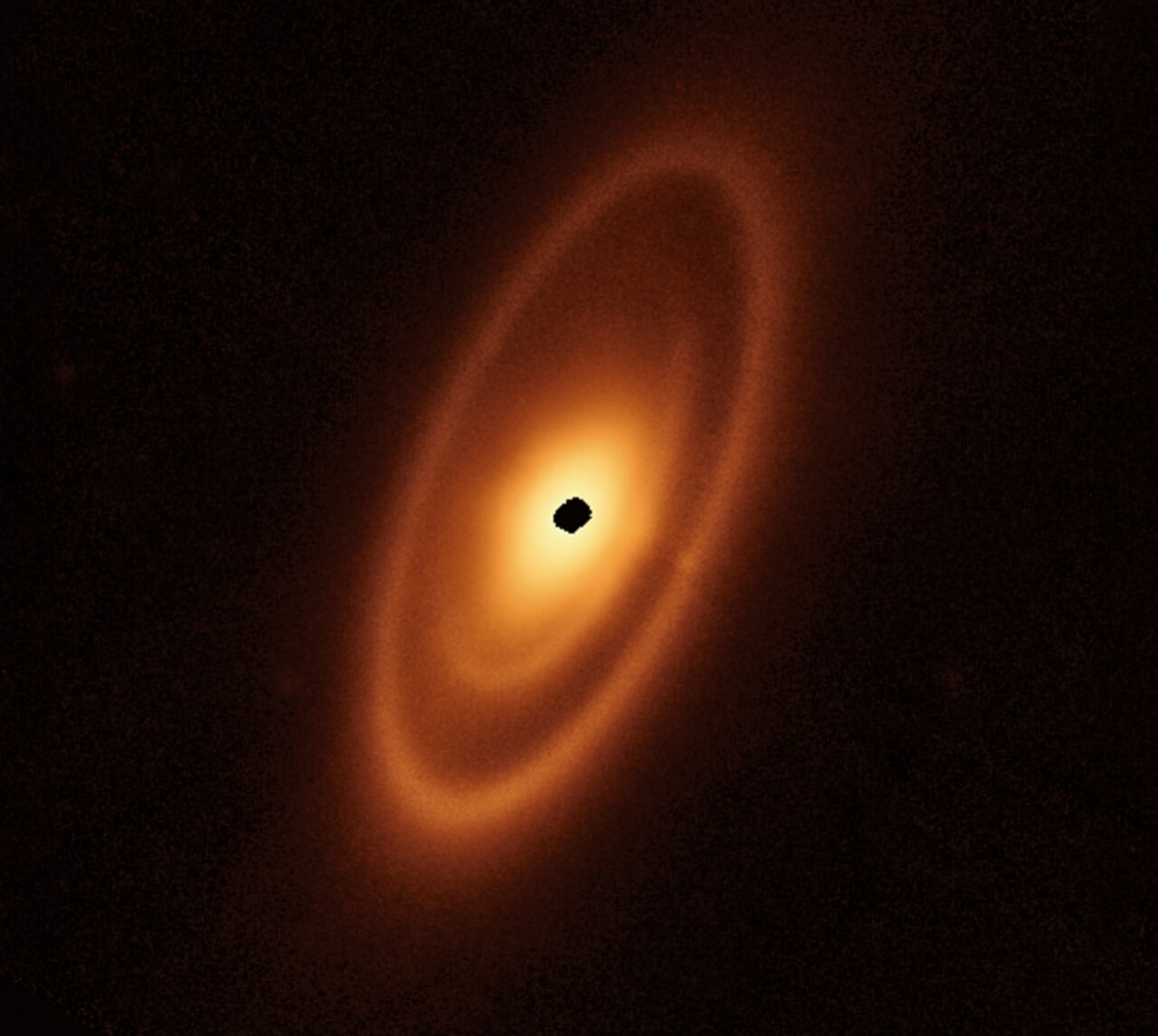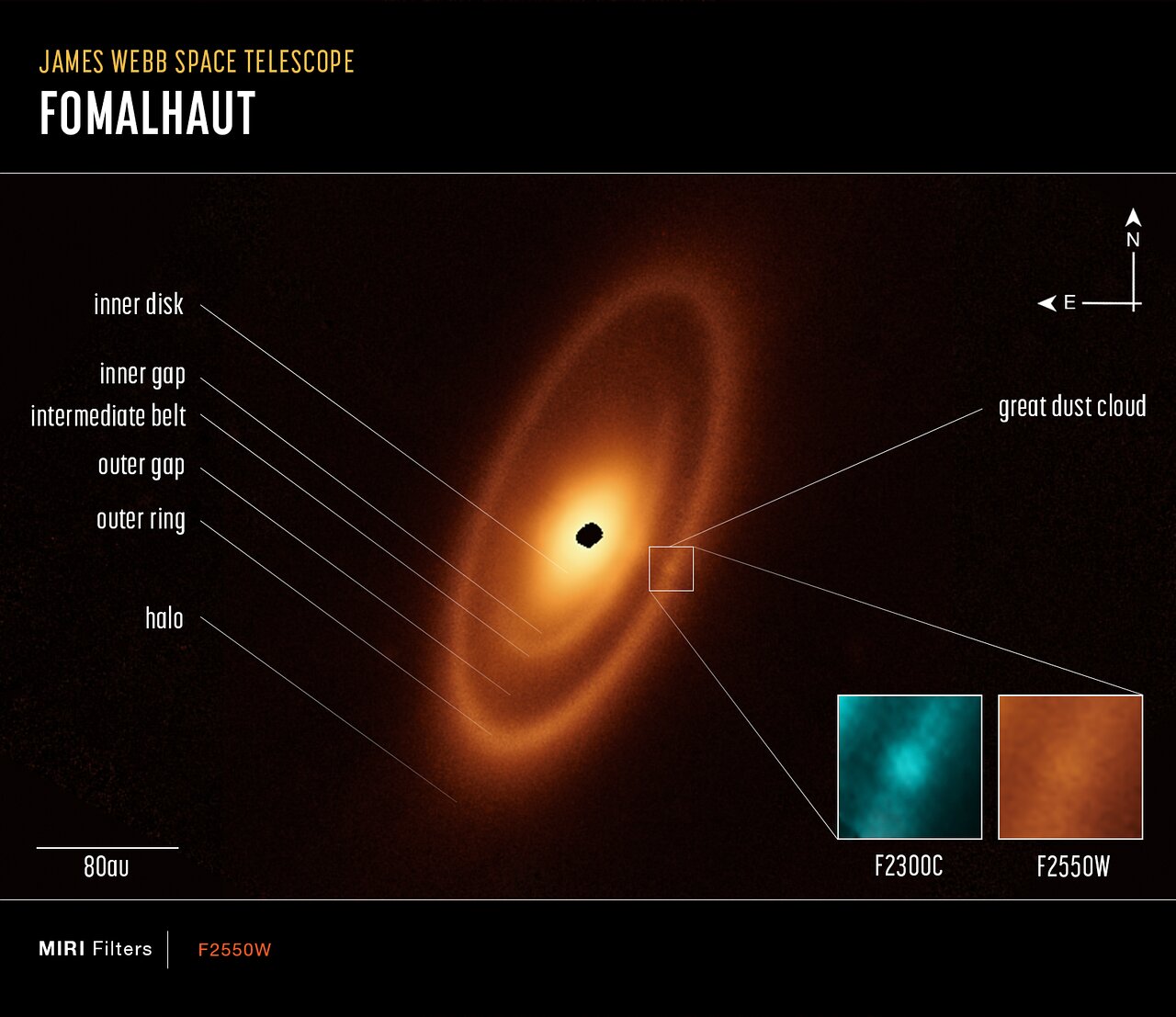From- Sky & Telescope,
By - Kit Gilchrist,
Edited by - Amal Udawatta,

NASA / ESA / CSA / A. Pagan (STScI) / A. Gáspár (University of Arizona)
Continuing its run of ground-breaking discoveries, the James Webb Space Telescope has snapped the clearest images yet of the dusty disk around the young star Fomalhaut.
Fomalhaut, a bright, young star 25 light-years away in the constellation Piscis Austrinus, illuminates a disk of planet-forming debris. Such debris disks contain clues about exoplanets and even smaller bodies that would otherwise remain hidden.
András Gáspár (University of Arizona) and his team present in Nature Astronomy images of the Fomalhaut system taken by the Mid-Infrared Instrument (MIRI) aboard the James Webb Space Telescope (JWST). The images reach a resolution and sensitivity far beyond the capability of earlier instruments. The team also analyzed new images taken by Hubble’s Space Telescope Imaging Spectrograph, in which the star’s light is blocked using a coronagraph.
Previously, Hubble, the Spitzer Space Telescope, and other telescopes have shown a far-out debris ring surrounding Fomalhaut that’s akin to the Kuiper Belt in our solar system. Analysis of the system’s brightness at different wavelengths had also suggested the presence of a dusty inner disk. Now, the new JWST images reveal unprecedented detail, including a new belt inside the first, an extended inner disk, and a gap between the two. They also show what might be a dust cloud in the outer, previously detected ring.
“My first thought was: ‘Wow!’,” remarks Samantha Lawler (University of Regina, Canada), who wasn’t involved in the study. “I spent a lot of time imagining possible orbital configurations for this system, so I was super-excited to see these detailed JWST images showing new belts and a new dust cloud.”
The innermost belt of dust the researchers discovered is analogous to the asteroid belt in our own solar system, but it’s much more extended than previously thought. Farther out, a gap is followed by an “intermediate belt” — these are both new discoveries. An as-yet-unseen exoplanet might have carved out the gap, and might continue to shepherd the belt, much as Jupiter’s gravitational effects shape our asteroid belt.

NASA / ESA / CSA / A. Pagan (STScI) / A. Gáspár (University of Arizona)
Farther still from Fomalhaut is a previously imaged outer gap in the rubble, followed by the outer Kuiper Belt-like ring. But new in the JWST images is a feature that the team has termed the “Great Dust Cloud,” which might have been formed by a planet-scale collision.
Alternatively, “it may well be a background galaxy,” Gáspár points out. “A follow-up observation will allow us to easily tell; if it’s part of the ring, it will co-rotate and likely expand in size.”
The putative dust cloud is reminiscent of another feature, Fomalhaut b, that astronomers had previously mistaken for an exoplanet candidate. Decades of observations ended up discounting the planet hypothesis, as the feature dissipated over time. The JWST observations are consistent with it being instead another collision-made dust cloud. The intermediate debris belt provides an additional source of material for collisions; moreover, it’s misaligned with the outer belt, increasing the odds of planetesimals going astray.
The overall picture that emerges is of a dynamic system that’s changing as we watch it. As Lawler puts it, “Maybe collisions between asteroids are common enough in this very close, very bright system that there are dust clouds constantly being created in collisions, expanding, and fading.” The belts of debris orbiting Fomalhaut may be the site of regular, explosive collisions, with icy and rocky bodies routinely crashing into each other, throwing up billowing clouds of dust. More observations will enable astronomers to confirm whether the “Great Dust Cloud” lives up to its name, as events unfold.
“Some of the next steps include testing whether the new blob that overlaps with the disk is actually a dust cloud in the system, or a background object, and seeing if we can find the hidden planets that the various disk features appear to point towards,” comments Markus Janson (Stockholm University), who also was not part of the study.
Lawler poses some other questions raised by the study: “How will the ‘Great Dust Cloud’ change? Will it also expand and fade away as Fomalhaut b did? Will new dust clouds appear from other collisions?” Computer modeling, she adds, can help astronomers narrow down the orbits and masses available to any exoplanets that might exist in the system.
Training JWST on the Fomalhaut system has already unearthed a tranche of secrets. “The level of detail is amazing,” says Janson. “There is no other telescope that can come even close to that performance.” More details lie tantalizingly within reach.
Comments
Post a Comment